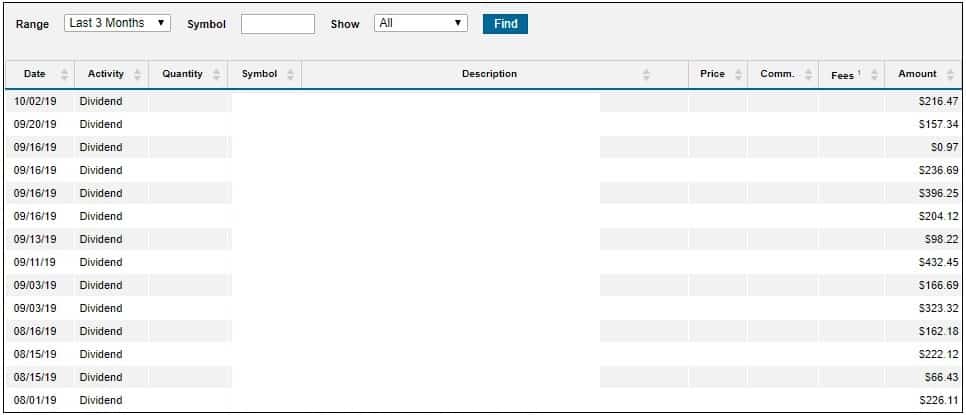When you think about your pool of money, it's important to think of it as a series of funds.
The two funds that people are most familiar with are your retirement fund and your emergency fund.
Your retirement fund can be spread out across several accounts: a 401(k), a Roth IRA, a pension, or whatever. The structure is unimportant. Conceptually, you think of them all as a retirement fund. For asset allocation, you want it to be aggressive when you're younger and slowly glide into a more conservative mix as you near retirement.
Emergency funds are like the first line of defense in your financial fortress. You can have them in a high yield savings account or in a CD, but the concept is to save 6-12 months of expenses in a yield-bearing account. It's there for protection, not to make money or grow significantly.
Once you've funded your retirement and emergency funds, it's time to build a Flywheel Fund.
What is a Flywheel Fund?
A flywheel is a mechanical device that efficiently stores energy, specifically rotational kinetic energy. In principle, you can store energy by spinning the flywheel and you can extract energy from that spin (which slows it down). The lower the friction on the bearings of the wheel, the more efficient is the storage. Basically, it's an old school battery.
When you start spinning a massive flywheel, it's very hard because you're starting from zero (no motion, no energy). But with each push, it becomes easier and easier until the flywheel spins on its own. Each subsequent push makes it spin faster and there's more energy stored in the wheel.
With that concept in mind, I have what I call a Flywheel Fund.
A Flywheel Fund is a fund (pool of money) that generates cash flow to offset our expenses. It's a storage of cash flow. At first, the fund only partially pays for our fixed and semi-fixed expenses. As it grows, through our own contributions and its own growth, it will eventually cover all our expenses. We build this while we have income from other sources, so we don't need the cash flow to pay for our expenses.
As you add more money to the Flywheel Fund, the cash flow can be reinvested into the Flywheel Fund. It starts to do something that doesn't happen in real life with a flywheel – it pushes itself! That's when it starts to feel like sorcery.
Where Does the Flywheel Fund Fit?
If you look at all your savings needs, a Flywheel Fund is the most junior of your savings needs.
These savings goals supersede your Flywheel Fund:
- Emergency fund
- Retirement savings
- Individual savings goals – house, car, vacation, education
Emergency funds, as long as you're lucky enough not to have to tap into them often, have finite ends. You reach 6-12 months and you are able to stop. (and if you're building one right now, an alternative to an emergency fund might help you satisfy stop gap needs)
Retirement savings are more nebulous because you have IRA limits as well as 401(k) limits. For 2019, the IRA limit is $6,000 and the 401(k) limit is $19,000 – totaling $25,000 a year. That's a ton!
Then, you have individual goals like a home and a car – again those are a little more nebulous.
The point of this isn't to prescribe how much you should save and where; that's for you to decide based on your schedule and needs. But, once you've reached your own limits for each, the next step is to build your Flywheel Fund.
How to Build Your Flywheel Fund
There is no single account that you can open and call your Flywheel Fund. It will be a series of accounts based on what you wish to invest in. The goal is to get a mix of assets that generate cash flow, and it will not be possible to find it all in one place.
The first step is to look at your other investments (such as retirement funds) and find asset classes that help with your allocation mix. You don't want to be too heavily invested in any one area and throw your allocation out of whack.
For example, your 401(k) is most likely going to be invested in volatile assets such as the S&P500 index. For your Flywheel Fund, you could look to dividend stocks or funds to generate cash flow but also offset the smaller cap nature of the S&P 500 (the S&P 500 is very big so there will be overlap, but I think you get my point).
Dividend stocks are a great base for a Flywheel Fund because they pay on a regular basis, are very liquid, and heavily regulated. Many a retiree have built a monthly dividend paycheck using blue-chip companies.
Alternatively, you could invest in a variety of other passive income investments such as real estate or farmland. They provide yields, are less regulated and less liquid, but aren't correlated with the stock market.
The Hidden Power of a Flywheel Fund
There is a hidden power lurking in a Flywheel Fund. As you save, and as it grows, your fund will provide greater and greater amounts of cash flow.
It will take time for your Flywheel Fund to grow. Brick by brick, stone by stone, it'll grow until the cash flow is something you can be proud of.
Once the cash flow from your Flywheel Fund exceeds your monthly expenses (all of them), you're financially free.
Listen, I get it. Dividends aren't as sexy as other investments (crypto!); but, over time, they become very impressive.
Many years ago, I was reading Warren Buffet's Berkshire Hathaway annual letter when he touched on their stock holdings. He was an early owner of Coca-Cola and has nearly four hundred million shares at a cost of just $1.299 billion (it's worth $18.940 billion). Last year, Coca-Cola paid Berkshire Hathaway about $624 million in dividends (2018). That's a yield of 48%. That's absolutely bananas!
I'm no Warren Buffet but this isn't too shabby!
One last point about financial freedom: the idea of financial independence has been closely tied to retiring early, (FIRE is a handy acronym!) but it's not necessary. Financial freedom gives you options and options are always good when it comes to designing your own life.
As an entrepreneur, I enjoy working on projects and building new things. Our Flywheel Fund gives me the flexibility to pursue these projects. It took a bit of sacrifice on the front end, but that sacrifice has blossomed during this remarkable bull run in the stock market to create a fund that generates cash flow we can use to support our spending.
You Can Rent a Flywheel Fund
A Flywheel Fund takes a while to build up, but what if you're concerned you might need cash flow before it gets there?
One close approximation to a Flywheel Fund is disability insurance. Disability insurance is essentially paying for a policy that replaces part of your paycheck if you cannot work. You pay premiums, just as you would save into a fund, and the policy produces the cash flow when you need it, like when you lose your job. The only difference is that the policy has no value, whereas a Flywheel Fund will still have the assets you've invested.
You can think of disability insurance as renting a Flywheel Fund that only produces when you're in a jam. It's not the same as building your own Flywheel Fund, just like renting a house is not anything like owning one.
Insurance does not replace a Flywheel Fund! It's merely there as a safety net. As your Flywheel Fund grows, and the cash flow grows, you should consider self-insuring against disability (rather than working with a disability insurance company). This means ending the policy and saving those premium payments in the Flywheel.
What do you think of my concept of a Flywheel Fund? Do you have something similar?





Jason says
Love it, this is exactly what we have been working on. A dividend account that will eventually pay our mortgage. We are measuring progress by the % of mortgage coverate the dividends cover. At 100% we will have significant freedom in that we will have a roof over our head allowing us to pursue other opportunities. Great name to have for it!
Ben says
Hey Jim,
I am very interested in good quality dividend stocks for a flywheel fund. What are some that you invest in.(not a financial recommendation, just curious).
Thank you for all the help!
Ben
The last time I invested in individual stocks was during the financial crisis around 2008-2010. I chose Dividend Aristocrats, which are S&P 500 companies that have increased dividends for at least 25 years, to start. Then I pared them down based on dividend growth (to outpace inflation), return on equity, dividend coverage, and a few other filters that I’ve since forgotten.
Don Milne says
I think flywheel funds have a very niche audience. Most people don’t have an emergency fund equal to one months expenses, much less 6-12 months. Most people aren’t saving enough to reach a comfortable retirement income. And since a flywheel fund comes after education, vacation, car replacement, and saving for a home downpayment, that means few people will have extra money for this. For those exceptional money earners who are also mindful spenders, it is a good idea.
You’re right, it is a smaller audience but so are topics like FIRE (financial independence, early retirement). The beauty of the internet is that even the most niche subjects get attention!
Rob says
I think of rental properties as my flywheel fund… are these more tax efficient for the average investors compared to dividends?
That’s a good way to think about them. They can be more tax-efficient if you can offset the rent with a variety of expenses related to the rentals. Otherwise, that income is still income and taxed higher than dividends.
Bill says
Jim,
Cool concept but the bucket you need to generate enough dividend to cover even a couple thousand in monthly expenses sounds daunting. What kind of money are we talking here? Even for your personal example, what’s the value of your accounts generating those dividends? I just struggle to see where that fits in the budget or the duration it may take to save it. Maybe we’re talking about a different level then I’m at. Like you to Buffett, I may be another rung ( or several rings down) from you. So it’s maybe an unrealistic option.
You are right, the bucket has to be quite big before it’ll cover a couple thousand a month. If you have a dividend yield of 3%, you’ll need $100,000 in that bucket to get $3,000 per YEAR. That’s a lot of money. I don’t disagree.
But the idea is that you’re growing this bucket slowly over time, investing it in assets that will offer greater and greater yields (like dividend growth funds or companies). The stocks I purchased in 2008 have appreciated tremendously. Almost all of them have at least doubled in value.
One company is Waste Management and my cost basis in that company is ~$11,000. The current value is almost $36,000. My dividend yield is 5.72% whereas the current yield is only 1.77%. That’s because the stock has increased in value so much.
This isn’t an overnight thing. You don’t turn the flywheel with one push. It’s many pushes over the year until it finally gets spinning.
TJ says
Another great post. I have something like this and have called it my “Future Income Stream.” Might change that to “Flywheel fund” in honor of your post I am older and don’t feel safe continuing with my all in on stocks strategy today so I’m investing in CDs, some high yield savings accounts, and anything else I find that produces an income stream. I was fortunate and started this when returns were around 3% and for now I simply leave extra money in my bank, interest bearing accounts, producing less than 3% and in most cases closer to 1% to 2%. It isn’t great. It’s better than nothing and similar to my current stock returns. It is also a known return, which gives me a warm fuzzy feeling. I also have a couple rewards credit cards that pay 2% returns on all expenses so that helps a little also.
My stocks, which are currently mostly invested in VTSAX, are producing less than 2% dividend returns. Have been watching the markets lately and am concerned with both the low dividend returns and trading volume. I don’t have decades to wait for the market to recover. Besides, it’s time for me to start going more conservative.
For now, the returns are simply reinvested, with the plan to continue letting this grow. Today my fund is only producing a little over $100 per month, I add a little to the bucket monthly, and it gets a little better each month. It will take a long time before it will produce what I spend monthly, and it’s a start. What is the old saying? Rome wasn’t built in a day. Neither is financial independence. We all have to start somewhere. The sooner the better.